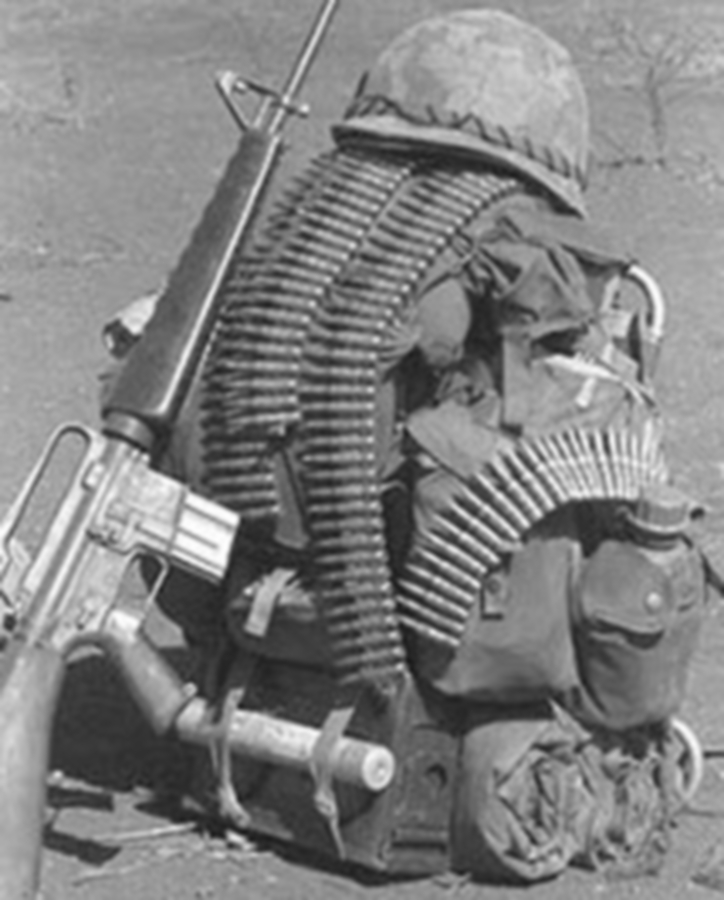
Carrying Heavy Weight in Combat - Some Historical Observations
October 15, 2021 - Major John Rickard
The issue of how much weight the infantryman can/should carry has never been truly resolved. What seems indisputable is that excessive weight impacts performance. In his well-known study On Infantry John English argued that D-Day “definitely showed that a direct relationship exists between an infantry soldier’s tactical performance and the load he carries on his back.”1 Over the years observers have offered opinion on what they believed to be the optimal weight. S.L.A. Marshall recommended just under forty pounds. Montgomery argued that somewhere between forty and fifty pounds was the limit and that every pound over fifty “definitely detracts” from a soldier’s fighting value.2 A veteran Second World War commander argued in 1950 that the optimal weight was just over thirty-three pounds.3
Despite the foregoing recommendations, the infantryman’s load has been gradually increasing since the end of the Korean War. In Vietnam the basic load was between fifty and sixty pounds. When all the ‘nice to have items’ were added, observers noted, the soldier “was bogged down to the point that his mobility was greatly decreased, and after a day’s walk he was physically exhausted. Every pound that a man carried reduced his ability to react and impaired his fighting ability.”4 By the time of the Falklands War British infantrymen were carrying approximately 100 pounds (or more). This was considered too much for Major D.A. Collett, MC, of the 3rd Battalion/The Parachute Regiment.5

A Canadian Army Lesson Synopsis Report (LSR) from February 2009 declared that conditions in Afghanistan “require soldiers to conduct intensive operations with loads far in excess of 35 kilos [seventy-seven pounds]”6 A section commander in 2 PPCLI noted that during Operation ANACONDA his ruck weighed approximately eighty-six pounds. He web gear was another thirty-two pounds for a total of 118 pounds, not including body armour, helmet and weapon.7 Despite knowing full well that infantry combat effectiveness suffers from excessive weight loads, Western soldiers remain heavily loaded in modern operations and could be accurately described as ‘heavy infantry’. David Kilcullen has argued that loads must be “ruthlessly” lightened to even begin to match the speed and mobility of ‘light’ insurgents.8 The psychological belief that more gear makes one safer, however, is difficult to overcome.9
Why do Canadian infantry need to carry such heavy weight? It seems illogical, especially when 2 PPCLI BG reported that personal protective equipment (PPE) “affects mobility and increases fatigue.” C Company declared that the extreme heat and heavy loads “led to a deterioration of battle craft.”10 A Master Corporal in Charles Company, 1 PPCLI reflected that the ten heat casualties suffered by his platoon in Panjwai in August 2006 was due to wearing eighty pounds and fighting in the heat.11 2 PPCLI concluded that “soldiers will never fully acclimatize to the heat” in Afghanistan. Acclimation has its limits, but one should also not lose sight of Major N.W. Lothian’s observation made way back in 1926 – no amount of training could ever condition a soldier to carry excessive weight.12 The infantryman’s load might actually be the most important physiological factor in tactical performance, even more important than hydration, sleep or nutrition.13
The trend of increasing the infantryman’s load is difficult to reverse. Modern technology and the so-called ‘revolutions’ in the way wars are fought appear to have profited the infantry little. As a junior officer in the CA you should consider the impact of the current infantryman’s load on planning including sustainment, tactics and psychology.
Notes
1 John A. English, A Perspective on Infantry (New York: Praeger, 1981), 178.
2 Montgomery to Crerar, 17 May 1942, Library and Archives Canada, Crerar Papers, MG 30 E157, Vol. 2, File 958C.009(D182).
3 Colonel John G. Van Houten, "Keep the Doughboy Lightly Loaded," Infantry Journal 66, no. 3 (March 1950): 13.
4 Infantry Magazine, ed., A Distant Challenge: The U.S. Infantryman in Vietnam, 1967-1972 (Nashville: The Battery Press, 1983), 83.
5 LCol John A. English, Major J. Addicott and Major P.J. Kramers, eds., The Mechanized Battlefield: A Tactical Analysis (Washington, D.C.: Pergamon-Brassey's, 1985), 109-10.
6 LSR (08-021), Equipment - A Soldier's Perspective, 20 February 2009.
7 Sgt Kenney, questionnaire filled out for Captain John N. Rickard, Wainwright, March 2003.
8 David Kilcullen, "Twenty-Eight Articles: Fundamentals of Company-Level Counterinsurgency," Edition 1, March 2006.
9 Sgt. Michael Hanson, "Coin Perspectives," Marine Corps Gazette 93, no. 4 (April 2009): 15-16.
10 2 PPCLI BG Post Operation Report - Operation Athena Roto 5, Annex L, M.
11 MCpl Matthew Parsons, "The Battle for Panjwai: A Soldier's Story," Legion Magazine 83, no. 1 (January/February 2008): 35.
12 Major N.V. Lothian, The Load Carried by the Soldier (London: John Bale, Sons and Danielsson, circa 1926), 56.
13 Todd C. Helmus and Russell W. Glenn, Steeling the Mind: Combat Stress Reactions and Their Implications for Urban Warfare (Santa Monica: Rand, 2005), 119.